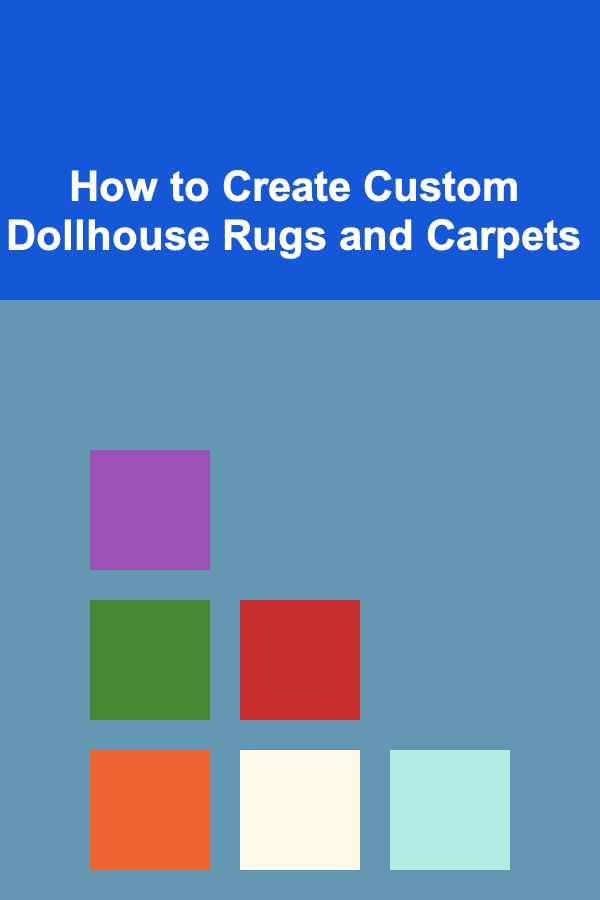
How to Create Custom Dollhouse Rugs and Carpets
ebook include PDF & Audio bundle (Micro Guide)
$12.99$5.99
Limited Time Offer! Order within the next:
Not available at this time

Creating custom dollhouse rugs and carpets can add an exquisite personal touch to your miniature world. Whether you are designing a charming living room for your Victorian-style dollhouse or adding a cozy feel to a modern kitchen, a well-made rug can transform the space. Crafting these miniature pieces of art allows you to showcase your creativity, attention to detail, and understanding of interior design. This guide will walk you through the process of making custom dollhouse rugs and carpets, offering you various techniques and ideas for designing and assembling these tiny masterpieces.
Choosing Your Materials
The first step in creating a custom dollhouse rug is selecting the right materials. The quality and texture of the materials you choose will have a significant impact on the finished look of your rug. Here are some popular options:
1.1 Fabric
Fabric is a common material for creating dollhouse rugs and carpets. Choosing a fabric with a pattern that matches the style of your dollhouse is crucial for achieving the desired aesthetic.
- Felt: Felt is a popular choice because it's easy to work with, doesn't fray, and comes in a variety of colors. It's ideal for creating simple and modern rugs.
- Cotton: Cotton fabrics allow for more intricate designs, such as floral or geometric patterns. They are perfect for creating realistic textures.
- Silk or Satin: For a high-end, luxurious look, silk or satin can be used for dollhouse carpets, giving a glossy, plush appearance.
1.2 Yarn and Thread
For a textured, woven rug, yarn and embroidery thread are fantastic choices. They provide the opportunity to create miniature braided or knitted rugs, which can add richness and depth to your dollhouse design.
- Embroidery Thread: Ideal for small cross-stitch patterns or creating detailed designs, embroidery thread comes in many colors, offering a wide range of customization options.
- Yarn: For larger rugs, yarn can be used to create more prominent, braided, or hooked designs. It offers a fluffy, textured finish that works well for more rustic or boho-style miniatures.
1.3 Paper and Cardboard
In some cases, paper or cardboard may be used as a base for your rug. These materials can be covered with fabric, yarn, or other decorative elements to achieve a layered look. Paper rugs are great for creating flat, intricate patterns.
- Scrapbooking Paper: Colorful patterned paper works well for creating flat, geometric rugs or carpets. The designs can be cut and arranged to form intricate shapes and patterns.
- Cardboard Base: A thin cardboard base can be used to stabilize the rug and prevent it from becoming too flimsy, especially when adding layers of material.
1.4 Beads and Sequins
For a truly customized look, you can add embellishments like beads, sequins, or even tiny buttons to your rugs. These small additions can elevate the design, adding sparkle or texture to the rug.
Creating a Simple Fabric Rug
Let's begin with a straightforward method for creating a fabric rug for your dollhouse. This simple approach works best for beginners but can also be customized to suit any style.
2.1 Step-by-Step Process
Step 1: Cut the Fabric
Start by measuring the size of the area you want the rug to cover. Use a ruler to cut the fabric to the desired dimensions. Make sure to add a little extra around the edges to allow for hemming or finishing the rug.
Step 2: Hem the Edges
To prevent fraying, fold over the edges of the fabric by about 1/8 inch and sew them down using a small running stitch. If you're using felt, you may not need to hem the edges as it won't fray.
Step 3: Add Design Elements
Now comes the fun part -- adding design details to your rug. You can either:
- Use fabric paint to add patterns, like stripes, geometric shapes, or even floral motifs.
- Stitch on additional elements like embroidery or applique to give the rug a more intricate and textured appearance.
Step 4: Secure the Rug in Place
Once the design is complete, glue the rug down on the floor of your dollhouse or leave it loose for a more relaxed look. If you choose to glue it, be sure to use a strong adhesive that works on fabric.
Creating a Braided Yarn Rug
A braided yarn rug is a classic option for dollhouses, particularly those with a rustic, farmhouse, or cottage-style aesthetic. Braided rugs add texture and a handmade charm to your miniature setting.
3.1 Step-by-Step Process
Step 1: Cut the Yarn
Start by cutting several strands of yarn in your chosen color. You will need about three to five strands, each about 12 to 15 inches long. These lengths will depend on the size of the rug you want to create.
Step 2: Braid the Yarn
Take the strands of yarn and begin braiding them together, just as you would with hair. Once you reach the end, secure the braid with a knot or by gluing the ends to prevent unraveling.
Step 3: Form the Rug
Once you've braided the yarn, begin forming the rug by coiling the braid into a spiral shape. Use hot glue to hold each loop in place as you go, ensuring the rug stays in the desired shape.
Step 4: Secure and Finish
Once the rug reaches the size you want, trim the ends and glue them securely. Allow the glue to dry completely before placing the rug in your dollhouse.
Creating an Embroidered Rug
Embroidered rugs are a perfect option for those who want to incorporate intricate patterns into their miniature spaces. This method is excellent for creating detailed, old-fashioned designs.
4.1 Step-by-Step Process
Step 1: Choose Your Fabric
For this project, you'll need a fabric that can hold embroidery stitches well, such as linen, cotton, or felt. Cut the fabric to your desired rug size.
Step 2: Draw the Pattern
Using a pencil or fabric chalk, lightly sketch the design you want to embroider onto the fabric. Consider using geometric patterns, floral motifs, or even a custom design based on the room's decor.
Step 3: Embroider the Design
Using embroidery thread and a needle, begin stitching your design onto the fabric. You can use various stitches like satin stitch, cross-stitch, or French knots, depending on your desired effect. Take your time to create a detailed and even pattern.
Step 4: Finish the Edges
Once the embroidery is complete, hem or finish the edges to prevent fraying. You can also add a border to frame your design and make the rug look more polished.
Step 5: Attach the Rug to the Floor
Once finished, glue the embroidered rug to the floor of your dollhouse or leave it loose. Embroidered rugs can add elegance and a sense of craftsmanship to any room in your miniature home.
Tips for Customizing Your Dollhouse Rugs
5.1 Mixing Patterns and Textures
Experiment with different patterns and textures to make your rugs more unique. Combine floral fabric with solid-colored yarn or add lace trimmings to create a more sophisticated look.
5.2 Scale Matters
Pay attention to the scale of your rug relative to the dollhouse. It's essential to ensure that the rug doesn't overwhelm the space or appear too small. Typically, a rug in a dollhouse should cover a portion of the floor, leaving enough visible space to show off the other furniture and decor.
5.3 Add Functional Details
If you want your rug to serve a more functional purpose in the dollhouse, consider using non-slip backing materials or adding a cushion underneath to give the rug a more realistic appearance.
5.4 Personalization
For a truly unique rug, consider adding personalized elements such as initials, monograms, or custom symbols. This adds an extra level of charm to your dollhouse and makes the rug truly one-of-a-kind.
Conclusion
Creating custom dollhouse rugs and carpets is an incredibly rewarding craft. With a little creativity, patience, and the right materials, you can design beautiful rugs that elevate the interior design of your miniature home. Whether you choose to make a simple fabric rug, a braided yarn piece, or an embroidered masterpiece, these rugs will undoubtedly add warmth, character, and a touch of personal style to your dollhouse. Don't be afraid to experiment with colors, patterns, and textures, and remember that the beauty of DIY miniature work lies in the details.

Affordable and Fun DIY Beauty Treatments to Pamper Yourself
Read More
How to Create a Luxury Look on a Budget with Affordable Textiles
Read More
How to Keep Cleaning Supplies Organized Under the Sink
Read More
How to Set Up a Pet Supply Donation System
Read More
How to Use a Grocery Budget Checklist to Reduce Food Waste
Read More
How to Create Engaging Printable Board Game Storylines
Read MoreOther Products

Affordable and Fun DIY Beauty Treatments to Pamper Yourself
Read More
How to Create a Luxury Look on a Budget with Affordable Textiles
Read More
How to Keep Cleaning Supplies Organized Under the Sink
Read More
How to Set Up a Pet Supply Donation System
Read More
How to Use a Grocery Budget Checklist to Reduce Food Waste
Read More